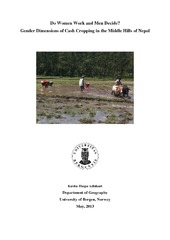| dc.description.abstract | ABSTRACT The study entitled Do Women Work and Men Decide? Gender Dimensions of Cash Cropping in the Middle Hills of Nepal'' was carried out in two villages in the Kaski District, Nepal, with objectives to document the existing farming system, motivational factors for adopting cash cropping and gender roles, especially in decision-making and labor division of agricultural activities. Data for this research was produced from two and half months of fieldwork conducted in 2012. Primary data were collected from a household survey (N=50) with purposive sampling, field conversations, case studies and observation. Acquired data were analysed using NSDstat to produce tables, figures and frequencies. The results show that the farming system is based on traditional skills and largely depends on monsoonal rain. In the past, farmers were largely involved in cereal crops for self-consumption but the farming system has been gradually transformed into market oriented production over the past two decades. Cash crops such as tea, amriso, cardamom, cucumber, garlic and seasonal vegetables are the main cash crops cultivated. Although farmers are involved in commercial agriculture, they largely use organic fertilizers such as compost and manure rather than chemical to increase growth. Institutions, migration, training and the high economic value of cash crops were the main motivating factors for adapting and increasing cash crops. Males appear to have increased their participation in a wider range agricultural activity since the establishment of cash crops, previously, the subsistence farming work was primarily done by women. The decision-making process in agriculture was found to be different depending on caste. The high caste (Brahman) involved all family members before the decisions were made and implemented, however women were rarely given the chance to take on any financial responsibility. The women of the middle caste (Gurung) made most decisions in agriculture and income because the majority of males had migrated domestically or internationally. Males were found to have exclusive decision-making power in the lower caste (Dalit). Regarding gender knowledge of crops, in particular lentils, no difference was found between genders, differences were observed only between the young and older generations. | en_US |
